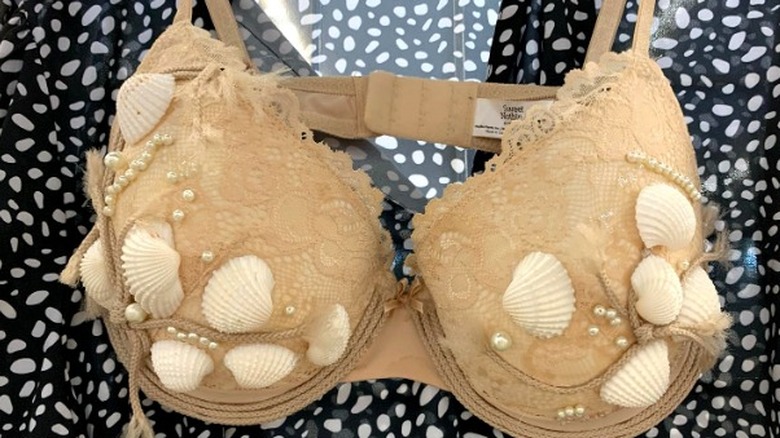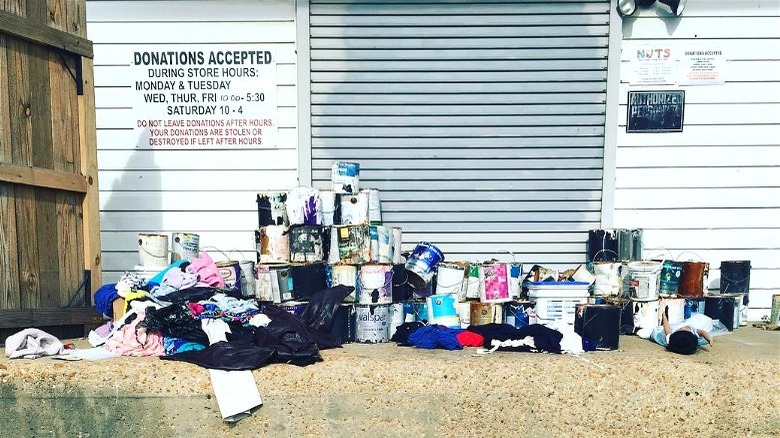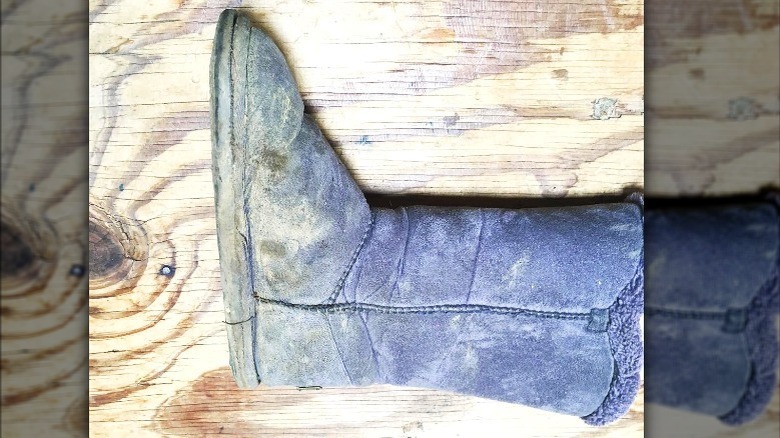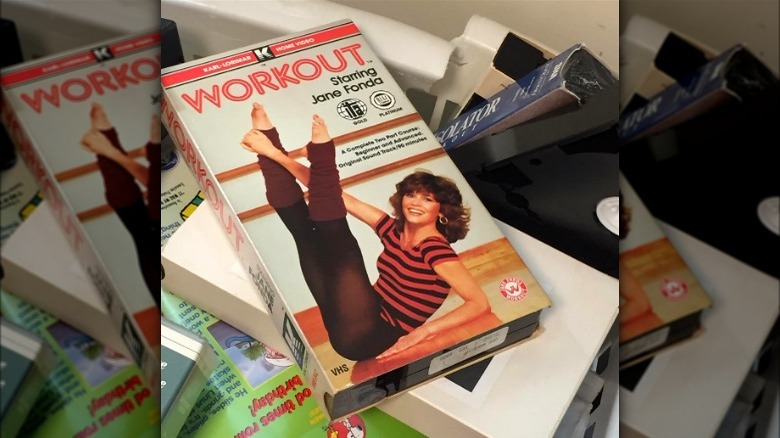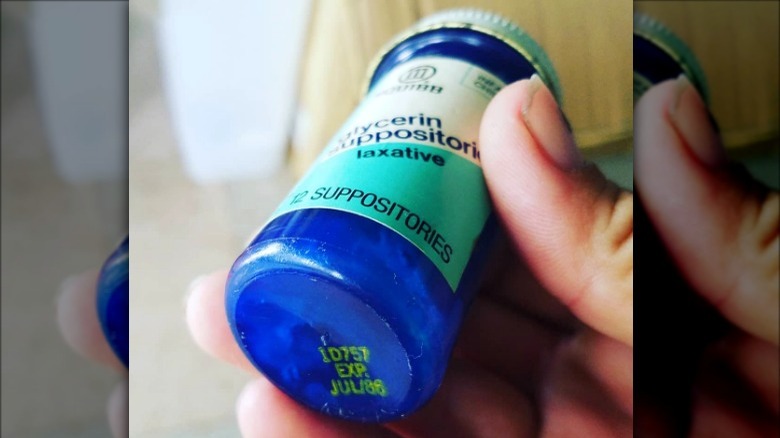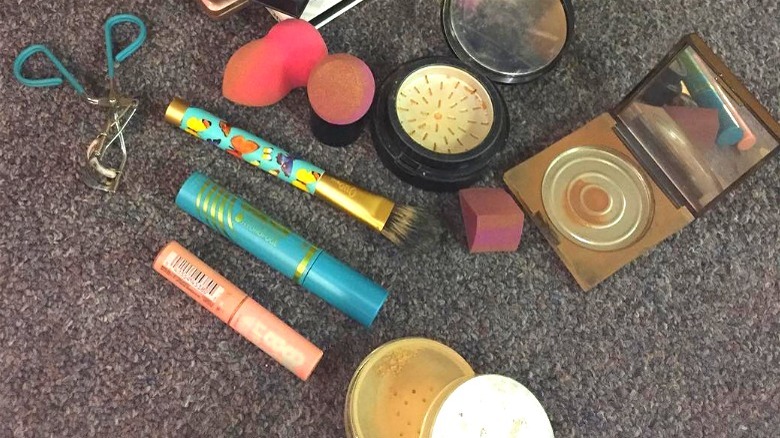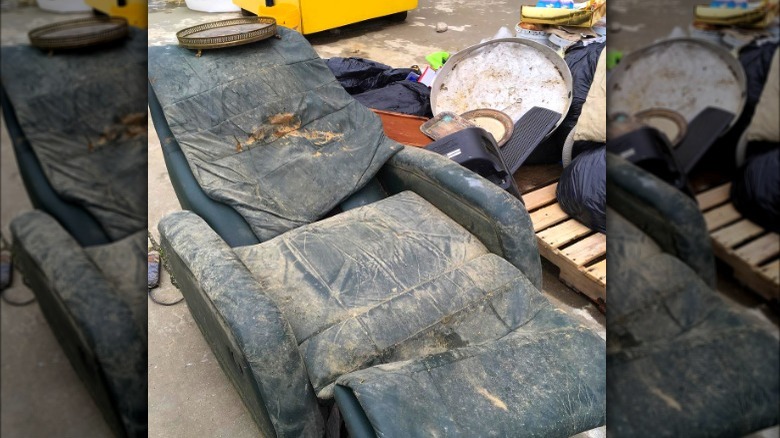Think Twice Before Donating These Items To Your Local Thrift Store
If we're being honest with ourselves, most of us have more stuff than we need. Even the most well-intentioned among us often find that we have an excess of clothing, home décor, or even furniture. So, naturally, this prompts us to spend the occasional Saturday afternoon purging our closets and storage areas with the best of motives — donating goods to local thrift shops or donation centers.
Sometimes, however, we get so caught up in our mission that we don't see the bigger picture. We're so focused on not throwing things away that we might overstep the boundaries of what is reasonable to repurpose. For example, the phrase aspirational recycling is used to describe the tendency to toss things into the recycling bin without understanding the guidelines. In an interview with Discover Magazine, recycling expert Pete Keller explained that people "think they're doing more by putting more materials in the recycling bin, but ... they're causing more harm than good" due to the difficult work of sorting the good from the bad.
The same holds true for our well-intentioned donations. It's important to understand what organizations will and will not accept. Although guidelines vary by location, most prioritize the dignity of the intended recipients and the usability of the items if used for resale. Some things are obvious, and you'll want to avoid adding to the supply of dirtiest items in thrift stores. But let's explore a few examples in hopes of making the most of the opportunity.
Everyone deserves dignity
The most important question to ask yourself when donating to thrift stores is rooted in basic human dignity. As a foster mom, TikTok user @fostertheteens reminds folks that if an item is too damaged or dirty that you would not want to use it, you should think twice before donating it. Echoing this sentiment, The New York Times summed it up by advising readers that if an item adds a sense of shame or embarrassment — like ripped or stained clothes — it's not appropriate to donate.
Decision time: What to do with that old Little Mermaid costume?
We all love a DIY hot glue moment, but let's just go ahead and skip this donation. While finding costume accessories at a thrift store is certainly not unheard of, the odds that any other human wants to rock your homemade costume are nearly nil. As for this seashell situation, if you can somehow remove the oh-so-elegant seashells without damaging the fabric, you might be able to donate it. But let's be honest. When was the last time you exercised restraint when wielding the power of the hot glue gun?
Paint cans are a hard no
Generally, paint is not accepted by donation centers and will create unnecessary work for the fine folks who sort community contributions. Although it may vary by region, usually latex paint can be put in the garbage, as long as it's dried out or mixed with kitty litter. Oil-based paint, however, is a hazardous material, so Lowe's suggests checking with your town. Having said that, you can call local non-profits who might need paint for a project, but this is a conversation as opposed to dumping paint cans in a donation bin.
Donation centers are not dry cleaners
Sometimes when cleaning out our closets and donating items, we're so focused on the task that we don't take every factor into consideration. But let's take a step back and remember that most thrift and donation centers are non-profits with small budgets. It's an excellent reminder to be more strategic with donations. Of course, these organizations don't have built-in drycleaning facilities, so make sure to clean items like boots before donating. Items that are unusable in their current condition are usually thrown away by donation centers.
We all love Jane Fonda but...
Of course, Jane Fonda's aerobics workout looks are all the mood board inspiration we need, but almost no one wants VHS tapes. Instagram user @asynja brings to light the surprisingly divisive nature of VHS tapes (who knew?). The point is this is on a case-by-case basis, so it's best to check the rules before chucking a slew of VHS into a donation bin. For example, suppose your local donation center won't accept them. In that case, the recycling experts at Shrink That Footprint suggest calling senior centers with clients that enjoy classic VHS content.
Oh, snap! Please shake that urn before donating
We hope we can safely assume human remains are not accidentally dropped off at thrift stores on a regular basis. But to avoid a situation similar to the one depicted in the above TikTok, let's make a pact right here and now to shake any urns before donating them. First of all because, eww, gross, and secondly, because the nice folks at thrift stores are often volunteers. They don't need that fresh brand of thrift-horror nightmares during or after a hard day of work.
Shockingly, thrift stores don't want suppositories from 1986
For the record, donation centers do not accept medications. This includes, but is not limited to, expired suppositories or, well ... suppositories of any kind. In this example of what not to donate, @goodsamships shares this decades-old bottle of medication that was included with a recent donation. On the one hand, it's nice to know folks want to help keep the contributions moving along, but next time, just donate a cute mug, some mittens, or a cozy sweater.
Sensibility is the foundation of good donating
Circling back on the theme of dignity, we're expanding that to include basic cleanliness as an essential guideline for donating. Yes, there are opportunities to donate unwanted makeup and beauty supplies. For example, More reports that many women's shelters will accept such items, but the rules vary by organization. The most widely accepted makeup donations are brand-new, seal-intact foundation or mascara. Some other things can, in theory, be sanitized, but each donation center decides what they will or won't accept. But donating grimy, empty, or years-old products is a general no-no.
Time for some real talk
Checking for clothing damage isn't solely about saving time for thrift store employees. Usually, after the clothing is sorted by what is wearable, approximately 80% is unusable and sold to recycling businesses. However, if you think recycling billions of pounds of clothing sounds good, there's one hitch. The Saturday Evening Post highlighted that out of that 80% of unusable donations, 45% of that clothing is exported to locations like Africa and Asia, where it's often sold at markets. But even there, damaged clothing is unusable and ultimately creates tremendous landfill waste, as seen @sustainablecherub TikTok video and a Business Insider story about Ghana.
Some furniture is too damaged to donate
Sure, there may very well be usable materials hidden underneath the upholstery of this broken recliner. The thing is, though, thrift shops and donation centers are not an upcycling hub staffed with carpentry enthusiasts willing to tackle the Herculean task of dismantling broken furniture to sort out the scrap metal and functional parts and pieces. Ultimately, in this scenario, it's better to say goodbye and bring this item to the dump, even if they charge a small fee.
Cleaning out? Be sure to check for mold
Sometimes, if items have been stashed away in a basement, attic, or closet, mold can develop. And this might not be obvious at first, so be sure to inspect clothing and home goods — inside and out — before donating. An example here might be food storage containers stacked inside one another. And, of course, places like basements can be pretty damp, so be especially mindful of any items stored in the cellar for long periods of time.

